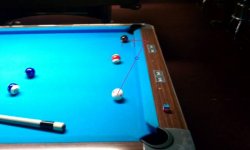Me said:
I, amongst others, would be happy to, if one of you would come up with a set of steps that define, unambiguously, where the
cue will be pointing after following those steps, either in actuality, or as you see it from the shooter's perspective (in the eye of the beholder). Guides to positioning your head and body are just not enough. Generally speaking, the difference between potting a ball and missing rather badly, is only a few tenths of a degree in cue direction, and sometimes less than even a tenth of a degree. Overall body, head and eye location are insufficient to restrict the direction of the cue on that scale (i.e., a slight tweak of the grip hand or bridge is enough to span that range). That's why watching someone sink shots, however adept they are at it, can't be taken as confirmation of the system. It's just too crude a metric.
I, and I think many others, would welcome any further clarification.
If you're referring to the small difference in cue direction that will make or break a shot, sure. But with ghostball, overlap or contact point aiming, ideally you align the cue to some definite point or line in space, which is the geometrically exact way to orient it. Obviously, you can only estimate it in practice, and the shot is only as good as your estimate and subsequent execution. But I wasn't referring to these real life problems in implementing the "theory."
According to what I've read thus far, Stan's DVD describes using the reference directions (edge-to-A,B,C and CTE) to get your eyes and body in some optimal position. That's all well and good, but then there's the matter of actually aligning the cue with something. According to the descriptions I've seen, that something is not defined. With your eyes and body all set up, there's still considerable leeway as to where you might actually point the cue. If you could get away with being 10 degrees off the ideal direction, or maybe even 5 degrees, having your eyes and body optimally aligned would probably make it awkward to have the cue misaligned by that much (i.e., enough to miss the shot). But, in actuality, it only takes a few tenths of a degree of misalignment to do so. Thus the question, how do you use those references (or something else) to point the cue? (I don't have the DVD, but this problem has been noted by those who do have it and are on the "contra" side of the debate.)
Jim
Jim,
Read post 250 in the CTE Test thread..It might answer your question a little better! If you are truely interested you should get the DVD!!
